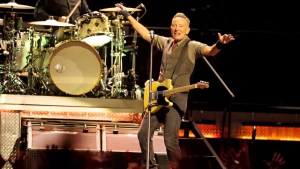‘Road Diary’ Review: Bruce Springsteen Documentary Brings Joy and Faces Loss
The third Bruce Springsteen documentary by director Thom Zimny to play at the Toronto International Film Festival, “Road Diary: Bruce Springsteen and the E Street Band” is also the biggest, the most expansive and the most all-encompassing. Ostensibly a chronicle of the world tour that Springsteen undertook last year, his first in six years, it also functions as a career retrospective of sorts. But more than that, it becomes a story of life and loss, because that’s the singular position occupied by the 2023-2024 tour.
Where “The Promise: The Making of Darkness of the Edge of Town” (TIFF 2010) was tightly focused on the tortured production of Springsteen’s 1978 album and “Western Stars” (TIFF 2019) was a document of a private performance of a more recent album, “Road Diary” takes a Springsteen concert as a template of sorts, which means it mixes joy and dread and love and regret and exuberance and silliness and seriousness; it’s intoxicating and it’s sobering, and it rocks like hell but confronts what’s been lost during Springsteen’s 74 years on the planet.
And there’s one other thing about “Road Diary”: It gives Springsteen’s fans a central place that “The Promise” and “Western Stars” couldn’t, allocating copious screen time to them along with the extensive rehearsal, backstage and concert footage from shows in the U.S. and Europe over the last two years.
The fan testimonials start to feel a little samey at some point, but they’re there for their passion, not their insight. And when the film premiered on Sunday night at the huge Roy Thomson Hall in Toronto, the applause from the audience on screen gradually merged with the cheering that was coming from fans inside the theater, adding a bracing jolt of communal electricity to a film that will be headed to Disney+ in October.
“Road Diary” isn’t a concert film; it contains substantial performances of more than a dozen songs and snippets of another eight to 10, but virtually all of the songs are edited down from their full stage versions, and they serve as jumping-off points for the rehearsal and interview segments and historical footage focusing on the onstage work that made Springsteen such a celebrated live performer from early in his career.
“You can’t understand a song’s possibilities until you count it off in front of an audience,” he says early in the film, as part of the voiceover narration that gives Springsteen a “written by” credit on the film. Compared to the more casual on-camera interviews with band members and manager Jon Landau, Springsteen’s audio-only narration comes across as a little stilted, but also eloquent; penning an autobiography and doing a run on Broadway with his solo show has honed his writing chops.
After briefly setting the tone, the film opens with a blast of the song “Ghosts,” an assertive ode to rock ‘n’ roll and to guitars “coming in from the mystic far,” and one of the four songs from his 2020 “Letter to You” album that figure prominently on the tour and in the film. But then the film backs up for a primer that uses the tour rehearsals as a way to explore some Springsteen history.

It also prepares the audience for the moment that feels as if it resets “Road Diary”: A shot of Springsteen walking onstage in Tampa, Florida as Landau says, “The man walking up the stairs in Tampa, he knows exactly who he is, he knows exactly what he’s doing.” That line got a round of applause in Toronto, and so did the blistering version of “No Surrender” that followed, the first song at the first show on the tour.
For the rest of the film, music from the shows alternates with explorations of Springsteen’s influences, his stagecraft and the themes around which the tour was organized. Lengthy sections from the guitar workout “Prove It All Night,” the soulful showstopper “Nightshift” and the jazzy, improvisational early song “Kitty’s Back” are bracing, but the film really moves to another level with the coupling of the acoustic ballad “Last Man Standing” and the 1975 classic “Backstreets.”
The transition between those two songs was in many ways the key moment in every show on the tour. The first song was written when Springsteen realized he was the last living member of his first band, the Castiles, and the second takes on layers of loss and regret when its piano intro rises out of the last mournful trumpet notes of “Last Man Standing.”
At this point the shows would shift into overdrive, and the movie does the same, though in considerably truncated form. At only 99 minutes, the film is about half as long as many Springsteen concerts on this tour, and it’s a good thing that Zimny got his start as an editor: The shifts from one song to the next are seamless and appropriate enough that 20 seconds of “Born in the U.S.A.” and “Glory Days” and a minute of “Badlands” and “Born to Run” manage to feel right rather than frustrating.
Sure, there’s a great concert movie in this footage, and given the prolific nature of the Zimny/Springsteen relationship (14 feature-length projects and counting), there’s a pretty good chance it’ll surface someday. But “Road Diary” does something altogether different: It uses the music documentary form to take the full measure of a man and a band grappling with mortality on a concert stage.
And if that’s not enough, it’s got a good beat and you can dance to it.









